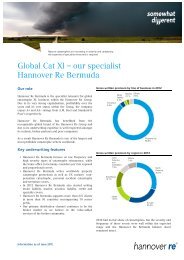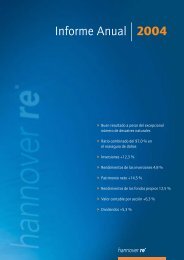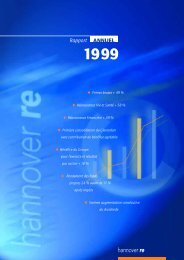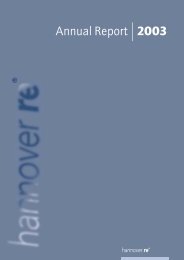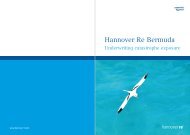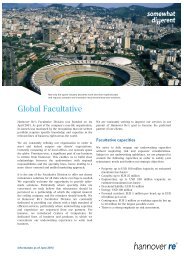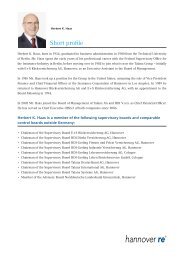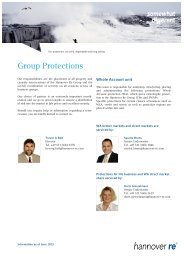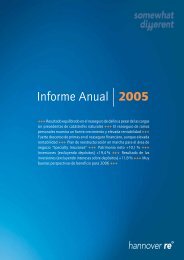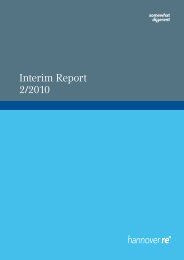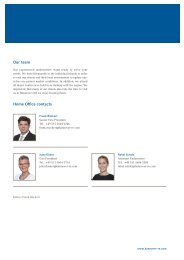Annual Report 2010 - Hannover Re
Annual Report 2010 - Hannover Re
Annual Report 2010 - Hannover Re
Create successful ePaper yourself
Turn your PDF publications into a flip-book with our unique Google optimized e-Paper software.
Opportunity and risk report<br />
Overriding goals and organisation of<br />
risk management<br />
Risk report<br />
Operationalisation of strategy<br />
The risk strategy derived from the corporate strategy constitutes<br />
the basis for our handling of risks and opportunities. The<br />
parameters and decisions of the Executive Board with respect<br />
to <strong>Hannover</strong> <strong>Re</strong>’s risk appetite are fundamental to the acceptance<br />
of risks. The risk strategy – as a self-contained set of<br />
rules – serves as the foundation for Group-wide risk management.<br />
It is an integral component of the guidelines for risk<br />
monitoring and risk steering and is reflected on the various<br />
levels of risk management and in the operational guidelines.<br />
The corporate strategy and risk strategy as well as the guidelines<br />
derived from them are subject to regular review. Through<br />
this scrutiny of our assumptions and any resulting adjustments,<br />
we ensure that our guidelines and hence the principles<br />
on which our actions are based are always kept up-to-date.<br />
The insights obtained establish a framework for decisionmaking<br />
on all management levels by bringing transparency to<br />
the relationship between opportunities and risks.<br />
The overriding goal of our risk management is to adhere to<br />
the strategically defined risk positions of the <strong>Hannover</strong> <strong>Re</strong><br />
Group which are enshrined in our risk strategy. In order to<br />
ensure that our shareholders’ equity is protected, we seek to<br />
manage and control individual risks such that the total risk<br />
remains within the permissible defined tolerances. Divergences<br />
may occur as a result of external influencing factors, and the<br />
company must always be in a position to immediately initiate<br />
appropriate countermeasures. We attach central importance<br />
to the following aspects:<br />
• <strong>Re</strong>gular review of the efficiency of systems and, as appropriate,<br />
adjustment to the business environment and/or the<br />
changed risk situation<br />
• Separation of functions between divisions that manage risks,<br />
on the one hand, and those that monitor risks, on the other<br />
• Process-independent monitoring by Internal Auditing<br />
• Systematic and comprehensive monitoring of all conceivable<br />
risks from the current perspective that could jeopardise the<br />
company’s profitability or continued existence with the aid<br />
of efficient and practice-oriented management and control<br />
systems<br />
Management report<br />
Operationalisation of the risk strategy<br />
Corporate<br />
strategy<br />
Risk strategy<br />
Framework guideline<br />
on risk management<br />
Limit and threshold system for the<br />
material risks of the <strong>Hannover</strong> <strong>Re</strong> Group<br />
Central guidelines: investments, exposure management, central<br />
underwriting guidelines (non-life and life/health reinsurance) …<br />
Local guidelines: e.g. local underwriting guidelines, signature rules,<br />
local contingency plans, deputising arrangements<br />
<strong>Hannover</strong> <strong>Re</strong> Group annual report <strong>2010</strong><br />
opportunity and risk report Management report<br />
55



